More than a year ago, I began spending time in the company of five student musicians.
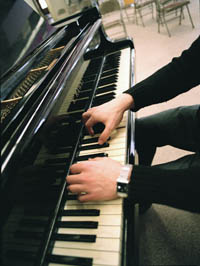
A varied group, they play piano and cello, alto sax and clarinet. They’re adept in a range of genres: jazz, orchestral, and chamber music; classical piano; and musical theater. One of the five sings a cappella. One accompanies singers and instrumentalists. Another, who graduated last spring, creates musicals.
I attended their rehearsals and concerts, their lessons and jam sessions. They talked to me about music and other passions: literature, neuroscience, and ancient history, and the languages they read—from French and Spanish to German, Mandarin, and hieroglyphics. Only one of these five has majored in music, yet music continues to soak up a great deal of what little free time they, as Brown students, have.
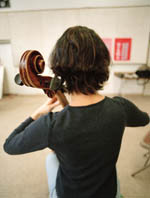
They are hardly alone. Each year, more than a thousand students take music courses at Brown, and nearly 600 participate in department-sponsored activities: the orchestra, jazz band, and wind symphony, and dozens of smaller ensembles. Most student musicians concentrate in other fields. The department graduates about twenty concentrators each year, but hundreds more practice for hours in the stuffy cubicles of Steinert Hall.
Many of these students play well enough to have gained entrance to a conservatory. But as high school students they all decided they wanted to attend Brown, and as Brown students they all decided to continue making music.
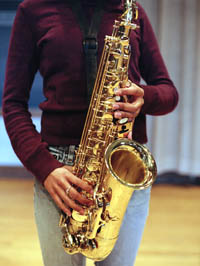
What motivates them? Some answers are obvious. Most of the students didn’t want the strictures of a conservatory, or didn’t foresee becoming professional musicians. Some realized they’d be encouraged to pursue their musical interests in conjunction with an academic focus at Brown; others wanted a broader education before going on to conservatory for graduate school. Without exception, all have found kindred spirits and talents at Brown with whom to create music.
“People don’t understand how much intelligence, concentration, and effort go into playing serious music, that you can’t just pick up a violin and fool around,” says music department chairman Todd Winkler. “It’s hard for people to understand this because it’s extremely difficult to explain a nonverbal process like music.” In the following profiles I’ve tried to give faces and stories to that process. Divya Vohra, Sam Carmichael, Eric Sedgwick, Olivia Wang, and Andy Hertz radiate a passion for musical expression that’s nearly universal among student musicians at Brown. Their stories show how vital love and discipline are to playing seriously. And how music delights them and those who listen.
The Energizer
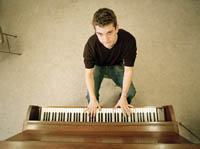
Genres: Jazz, fusion, a cappella
Concentration: English
On a frigid Thursday evening in December, members of the jazz combo dribbled into a chilly Fulton Rehearsal Hall, opened their instrument cases, and began to warm up their instruments and themselves. Most kept on their jackets; some, their hats. Dave Zinno, the group’s coach—a bearded, jeans-wearing, forty-something professional bassist who teaches in the applied music program—distributed sheet music to the players and bantered with them. The trumpeter played meandering riffs; the electric bass player unleashed a landslide of notes; the drummer bopped the snare and cymbals. The cacophony ricocheted off the walls.
Then Sam Carmichael whirled in, zoomed over to the Kawai concert grand, and flung his six-foot-three frame onto the bench, simultaneously peeling off two layers of sweaters. From a large brown-paper bag he removed an enormous roast beef sandwich on a Kaiser roll and pushed half of it into his mouth. As Zinno signaled the rehearsal’s start, Carmichael, still chewing, played the introductory vamp for George and Ira Gershwin’s “Love Is Here to Stay.” Magically, the cold, dingy studio seemed transformed—like a black-and-white shot of Manhattan brought to life by a Woody Allen soundtrack.
Baritone Adam Green ’05 spun the lyrics mellifluously, and Carmichael was attuned to his phrasing in a way the word sensitive can’t begin to describe. Although other players took the spotlight when their solo improvisations kicked in, it was Carmichael’s piano that sustained the song’s momentum and shape.
When the song ended, the spell dissolved, and Carmichael stuffed the other half of the sandwich into his mouth. “I didn’t have time to go to the Ratty tonight,” he explained, crumbs spewing into space. “So I got takeout.”
A John Hay Scholar and an English concentrator, the lanky, curly-haired, hazel-eyed sophomore also plays electric keyboard for an all-student fusion-jazz combo known as High Life and has sung with the Jabberwocks, Brown’s oldest male a cap?pella group, since freshman year. Now he also directs the group, selecting and arranging songs and running rehearsals.
Carmichael attended high school in Brattleboro,Vermont, home of the Vermont Jazz Center. His father, a college professor, plays acoustic and electric guitar; his mother, a graphic designer, plays guitar and sings. His younger siblings, Emma and Joey, sing and play alto sax, respectively. In adolescence Sam took up tenor sax and guitar; he later studied classical piano to bolster his technique.
The latter, he says, gave him finger dexterity and sensitivity to hand position. He plays with elegant alignment—torso strong and straight, arms relaxed, graceful and flexible. Core strength allows him to move effortlessly over the keys. As the jazz combo rehearsed, his hands were in perpetual motion, his feet relentlessly worked the pedals and tapped rhythm, his head nodded, and he sang along with the melody.
Carmichael considered attending a conservatory, but the music department’s Web site convinced him there’d be opportunities at Brown both to study in the applied music program and to do related coursework. (Last year he took Jazz Transcription and Analysis.) Still, Carmichael chose English as his concentration. “One of the conclusions I reached was that everyone at Brown gets a similar base education, rich in writing and critical thinking,” he says. “I reasoned that I might as well pursue what I love, as opposed to latching onto a major that led to a very specific career. I plan to continue to graduate school at some point. But at the moment I’d rather just read, write, and discuss great works of literature.
“I don’t see myself as a professional musician,” he continues. “But I just love music so much—it’s always been a major part of my life, a major form of identity. I stick with it because I need it in my life.”
The Intimate Expressionist
Olivia Wang describes herself as “quiet and gentle-natured, but stubborn when provoked; tall and slim, and unlike other Asians, I have naturally curly hair.” She favors pastel accessories—barrettes, hair ribbons, blouses. She wears flippy short skirts, or blue jeans and flat dark-red Mary Janes. She loves junk food. Her rounded face is serious and sweet; curls spill forward as she leans into her cello, bowing the foundation line of a Debussy trio, a Piazzolla tango, a Beethoven sonata.
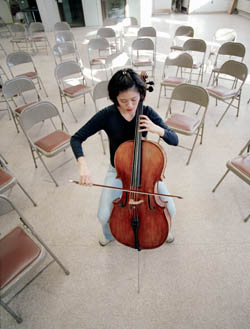
Instrument: Cello
Genre: Classical, especially chamber music
Concentration: Egyptology
An Egyptology concentrator whose love of Middle Eastern culture was nurtured by her father, a Hong Kong businessman who travels frequently to the Arab world, Wang studies archaeology, ancient history, and literature. She also reads hieroglyphics and hieratic texts. (On the modern side, she’s fluent in Mandarin, English, French, and German.) “My dream holiday,” she says, “would be riding a camel and camping in the desert.” Last summer, after finishing an internship at Sotheby’s auction house in New York City, she traveled to the Middle East on her own, for the first time, to visit a Jordanian friend and see the excavations at Petra being conducted by archaeology professor Martha Sharp Joukowsky ’58.
Wang’s frequent traveling companion is her 1938 Italian cello, which commutes with her between Hong Kong and Providence. When she attended boarding school in England, the cello went, too. At Brown, Wang has done coursework in applied music—cello lessons and chamber ensemble—and taken a couple of music theory and music history classes. She played in the Brown orchestra during her sophomore year, but since then her primary focus has been chamber music. “It’s more intimate than the huge production of an orchestra,” Wang says. “I like the way each part has its own distinct voice, and how this voice interacts with the others to express a musical idea.”
In her junior year she persuaded pianist Jason Zhang ’06 and violinist Keiko Hayakawa ’05 to play an early Debussy work, the rarely performed Piano Trio Opus 20 in G minor, written when the composer was eighteen. The piece reflects the orientalism of the late nineteenth century. When Wang first heard it, she was “immediately taken in by the atmospheric quality. It is so quintessentially impressionistic—dreamy, delicate, and shimmering.”
Coached by applied music instructor Lois Finkel, a violinist in the Rhode Island Philharmonic, the group performed the Debussy work at Grant Recital Hall in December 2003—its Brown premiere. Then, in the spring, when Hayakawa was on a study-abroad program, they gained a new violinist, Cindy Beavon ’07, and continued the trio, playing works by Brahms and Piazzolla.
Although Wang practices two hours daily, in rehearsal she sometimes looks worried as she listens for the line. Her gaze shifts rapidly from sheet music to the violinist and pianist. Eye contact, slight nods, and sharp intakes of breath are the cues that synchronize rhythm and that define passage-work and thematic statements, beginnings and endings. Utterly concentrated, her face rarely registers pleasure in rehearsal. Her task, like that of the other players, is the creation of a unified interpretation, and there must be consensus about the expression of every note and every phrase. Getting to an understanding generates long discussions.
Paul Phillips, director of chamber music and conductor of the Brown Orchestra, characterizes chamber music as “a nonverbal communication that people who don’t play rarely experience. For thirty to forty minutes at a time you’re fiercely listening to what everyone else in your group is doing. It goes beyond listening—you’re anticipating, reacting, blending continuously on a level where nothing is hidden, everything is open. In that way it differs from orchestral playing in being so much more exposed.”
“Being friends as well as musicians in a chamber group is important,” Wang observes. “Of course, compatible levels of musicianship and skill are essential to achieving good results. But we play well because we are able to freely exchange our musical ideas.” She smiles shyly. “Playing chamber music at Brown allows me to experience music-making with others sharing the same interests. It also provides me with a means of escaping the rigors of academic studies.”
The Power Player
“On a good day I’m about five feet tall,” says sophomore Divya Vohra with a hopeful lilt. “But when I play the saxophone, I feel powerful.” Together, she and her saxophone weigh 100 pounds.
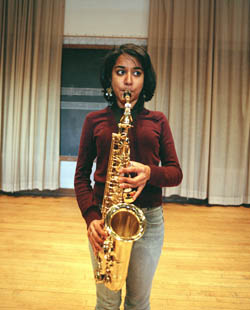
Instrument: Saxophone
Genres: Classical, jazz
Concentration: Cognitive neuroscience
Vohra started playing piano at age eight but switched to alto sax at eleven. “It was the biggest instrument they would let me play,” she says. “The other band instruments my friends were playing were too girly—flute and clarinet.” Vibrant in a striped multicolored scarf, red sweater, and grass-green slacks, Vohra says her favorite color is “anything bright.” A small diamond sparkles on the side of her nose. She walks swiftly and laughs often. She’s a vegetarian. She speaks Hindi and Spanish. She has traveled extensively in India and visited Europe, Costa Rica, and Peru. (“Amazing! I can’t wait to go back! I really want to study abroad there!”)
When she plays the saxophone, the sound emerges in smoothly modulated arcs, without breathiness or rasping. Playing so seamlessly and expressively takes strength and intense concentration, but Vohra makes it seem as simple and natural as breathing.
One day last winter, she began a saxophone lesson with breath work, first to warm up the instrument’s brass, then to articulate both sustained and short notes. Ed Tomassi, who teaches in the applied music program, divided her remaining time between an étude by Mulé, which she would have to master for her final exam, and improvisational work on a jazz standard by Harry Warren, “There Will Never Be Another You.”
Tomassi took her through the melodic statement; then they worked on short variations involving riffs on motifs within the song. Vohra stood attentively while he sat at the piano, sometimes accompanying her, sometimes demonstrating rhythm or phrasing at the keyboard or on his own sax, which rested on top of the piano. An atmosphere of calm concentration filled the studio as they discussed phrasing and dynamics.
Vohra plays in both the wind symphony and the jazz band, attending back-to-back rehearsals for three hours, two nights a week. In addition she must practice for her weekly sax lesson, and complete daily keyboard homework for a course she is taking called Theory of Tonal Music. That and her other courses (neuroscience, cognitive science, history) leave little free time, although she does squeeze in a little volunteer work for Amnesty International.
As a high school senior in East Greenwich, Rhode Island, Vohra was headed to Oberlin College, where she’d been admitted to the conservatory, but at the last minute she changed her mind. “I love the people here,” she says, smiling expansively. “I enjoy the academic philosophy, especially in comparison to what my life would have been like if I had been at a strict music conservatory.”
She pauses. “There’s a conception that if you don’t go to a conservatory it somehow makes your musicianship less valid,” she says, more soberly. “I’ve been exposed to so many amazing musicians at Brown. I see that they’re pursuing other courses of study than music, but it doesn’t change the fact that they’re still really passionate about what they do. You can be a happy and successful musician at a liberal arts university—it’s all what you make of it.”
The Musical Gymnast
“My favorite literature is probably modernist,” says pianist Eric Sedgwick. “Faulkner. Joyce. Woolf. It’s similar to my taste in music: I prefer authors who convey a strong sense of form and structure—and experiment with them.”
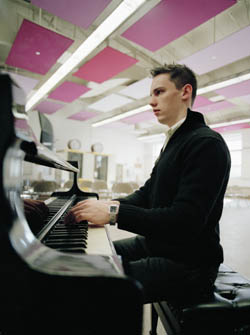
Instruments: Piano, clarinet
Genre: Classical
Concentration: English
While finishing high school in Worcester, Massachusetts, Sedgwick decided against attending a conservatory, although he was adept at both piano and clarinet and had a strong interest in chamber music. “I had too many other interests,” he says, and he “worried that the rigor of a conservatory might take all the fun out of music.”
So he concentrated in English, and now, in his last year at Brown, is applying to top U.S. conservatories for graduate work. Linda Jiorle-Nagy, an applied music instructor with whom he’s studied since freshman year, is helping him prepare audition pieces that showcase his affinity for Romantic and Impressionist music—Beethoven’s “Appassionata” sonata, Brahms’s third sonata, Ravel’s “Le Tombeau de Couperin,” and a Debussy étude. Sedgwick, she says, “has something to say when he plays. There is an elegance and a lyricism, as well as a powerful technical facility.”
For the past three and a half years, Sedgwick has performed extensively as a soloist, a chamber player (as pianist and clarinetist), an accompanist, and a member of the Brown orchestra, where he regularly plays clarinet and, occasionally, orchestral piano. As a sophomore he won the music department’s Margery MacColl Award and as a junior, the Buxtehude Premium. Now a senior, he won the orchestra’s concerto competition and will perform the Brahms Second Piano Concerto in May.
Five-foot-nine, Sedgwick has the physique of the gymnast he was from elementary school through high school. His specialties were the high bar and floor routines. His upper-body strength serves him well in the execution of lengthy pieces requiring stamina and sustained sensitivity, such as Schumann’s Carnaval, which he performed in recital last spring. Watching him play the Steinway concert grand in Grant Recital Hall, it was easy to forget the technical difficulties the twenty-one sketches pose. From the assertive power needed to dig into the majestic chords of the “Preamble” to the delicate agitation and nimble finger work required of the arpeggiated musical portrait, “Chopin,” to the noble finale in which Schumann envisioned the triumph of art—in all of these passages Sedgwick revealed the music’s inner life. As he played the Schumann, which increases in force and velocity as it concludes, his hands moved with a sureness born equally of strong technique and an understanding of how meaning is shaped through articulation, phrasing, and dynamics.
No flashy prodigy who goes in for showy effects, Sedgwick expresses a calm, deep relationship with music in all its nuances. Playing a woodwind enhances his pianism—particularly with regard to lyricism and breathing, which, he says, “pianists don’t understand so much. I think about a line as ‘How would I play this on clarinet?’ and it helps a lot.”
That reflection is typical of Sedgwick’s approach to academics, music, other people—everything he cares about, especially performing. He is actively thinking when he performs, says Jiorle-Nagy, “not just doing what he has been told, or what he has practiced.” Sedgwick says his goal is to communicate, especially with those unfamiliar with classical music. “I want the audience to enjoy the music,” he says. “I want to feel connected with them, or it’s not fun at all. I like to convey the form of the music, where I am in the piece, what the major themes are. If you don’t do that, a lot of this music sounds really long.”
The Graduate
“During my freshman year,” says Andy Hertz, “Professor [of Music Gerald] Shapiro asked me what I wanted to do with my life. And I was scared to admit I wanted to be a musical director for Broadway.” Shapiro downplayed Hertz’s fears. “He said, ‘Well, you could be a starving artist, or you could be the next Jerome Kern.’ ”
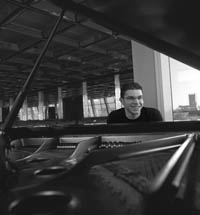
Instrument: Piano
Genre: Musical theater
Concentration: Music
Encouraged, Hertz enrolled in music and theater classes and took on his first extracurricular theater project, directing You’re a Good Man, Charlie Brown. He followed that with a full Broadway slate: A Chorus Line, Cabaret, Design for Living, Anna Karenina, Oh, Coward!, Bat Boy: The Musical, Into the Woods, and Tick, Tick, Boom. He directed cabarets for the Musical Forum and Sock and Buskin. Off campus, he worked with local grade schools and Providence’s Trinity Repertory Company to direct the children’s musical Annie Jr. Last spring came his homage to Brown, cowritten with Lance Rubin ’04, The Best Brown Musical Ever: The Musical.
If you didn’t know what to look for, Hertz’s work on these productions was invisible. He’s the quintessential behind-the-scenes person—the arranger of songs, the offstage player of piano or electric keyboard, the leader of the small backup ensemble in the shadows, the lyricist; he’s the tireless presence at rehearsals, endlessly reviewing songs and musical cues, and adjusting vocal balances. At the end of a show, after the cast took curtain calls, the spotlight would focus on Hertz, seated at the keyboard or emerging from the wings, almost always wearing black jeans, black sneakers, and black T-shirt—stocky, curly-haired, bespectacled. He’d smile and take a quick bow, and most of the audience would barely know who he was or why he was out there.
But without him the show, literally, couldn’t have gone on. “He is a great collaborator,” says Professor of Theatre, Speech, and Dance Lowry Marshall, who worked with Hertz on the summer 2003 production of Oh, Coward! at Leeds Theatre.
Hertz argues that Brown’s music and theater courses, its close ties to Trinity Rep, its performing spaces, and the music collections of the Orwig and John Hay libraries, make it one of the best places for an undergraduate to study musical theater. After graduating last spring with a degree in music and the department’s music prize, he is now in Manhattan, at New York University’s Tisch School of the Arts, where he was admitted to its selective graduate program in musical theater writing.
There are only twenty-one students in the program, and Hertz confesses that the constant closeness sometimes reminds him of elementary school. He’s loving it, though. “There are no grades, no papers, tests, or anything like that. We present our material in lab once a week and get feedback from the faculty and students. You are paired with a lyricist—or composer, depending on your specialty—every other week to complete a project. This week I was working on making an extended musical sequence, something like the montage in A Chorus Line or the “Tonight” number from West Side Story. Our final project of the semester is a ten-minute musical fable. Next year we work on our thesis project—a full-length musical that gets a professional reading.”
But Hertz is also facing the realities of show business, coming to grips with the fact that talent, in the long run, is only part of the story. So he’s formulated the following recipe for success: one-third talent, one-third intelligence, and one-third connections. “I’m not the best writer in the class,” he acknowledges, “but I am a good shmoozer.”
Selma Moss-Ward, an amateur classical pianist, teaches creative nonfiction in Brown’s English department.





